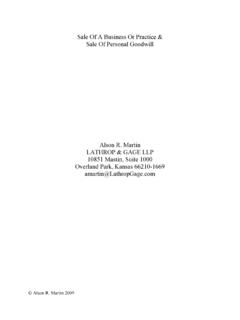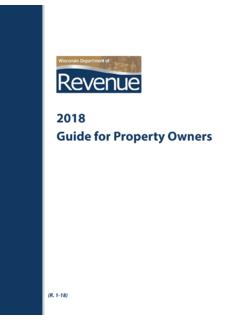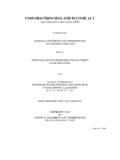Transcription of INCOME TAXATION OF TRUSTS AND ESTATES …
1 1 INCOME TAXATION OF TRUSTS AND ESTATES JEREMIAH W. DOYLE IV SENIOR VICE PRESIDENT BNY MELLON wealth management boston , massachusetts september , 2010 Jeremiah W. Doyle IV, All Rights Reserved Introduction Part I - Overview of INCOME TAXATION of TRUSTS and ESTATES I. Overview of INCOME TAXATION of TRUSTS and ESTATES - Types of TRUSTS : Simple, Complex and Grantor - trust Accounting INCOME II. Tax Rates of TRUSTS and ESTATES - Taxable INCOME - Adjusted Gross INCOME - Estimated Taxes - When an INCOME Tax Return is Required III. trust and estate Distributions Differences IV. Simple TRUSTS V. Complex TRUSTS and ESTATES - The Tier System - Effect of the Charitable Deduction VI. Separate Share Rule and Unequal Distributions VII. 65 Day Rule VIII. Distributions Not Subject to the Distribution Rules - 663(a)(1) Part II Computation of Taxable INCOME I.
2 Introduction II. Fundamental Rules of Subchapter J III. Exemptions for ESTATES and TRUSTS 2 IV. Charitable Contributions - 642(c) V. Net Operating Loss Deduction VI. Depreciation - 642(e) VII. Unused Loss Carryovers and Excess Deductions on Termination of TRUSTS and ESTATES VIII. Administration Expenses IX. Computation of Tax Liability X. Credits Available to ESTATES and Beneficiaries XI. Nondeductible Expenses XII. Miscellaneous Itemized Deductions XIII. Alternative Minimum Tax Part III Example of a 2009 Fiduciary INCOME Tax Return for a Complex trust 3 INCOME TAXATION OF TRUSTS AND ESTATES JEREMIAH W. DOYLE IV SENIOR VICE PRESIDENT BNE MELLON PRIVATE wealth management boston , massachusetts september , 2010 INTRODUCTION The INCOME TAXATION of TRUSTS and ESTATES is a one of the most complicated areas of the Internal Revenue Code.
3 This outline seeks to demystify fiduciary INCOME TAXATION and is broken down into four parts. Part I provides an overview of the federal INCOME TAXATION of TRUSTS and ESTATES . It discusses the differences between a grantor, simple and complex trust and the tax consequences of each to the trust and the beneficiary. Part II discusses the technical aspects of computing a trust or estate s taxable INCOME . A detailed discussion of the fiduciary INCOME tax charitable deduction and the allocation of a depreciation deduction between the estate or trust and its beneficiaries are among the topics discussed in this part. Part III discusses compliance and procedural issues that the fiduciary needs to know. Part IV is an example of a 2009fiduciary INCOME tax return for a complex trust . This outline should be helpful in understanding how ESTATES , TRUSTS and beneficiaries are taxed as well as guidance on the procedural and compliance issues facing the executor or trustee.
4 PART I - OVERVIEW OF INCOME TAXATION OF TRUSTS AND ESTATES I. Overview of INCOME TAXATION of TRUSTS and ESTATES TRUSTS and ESTATES are separate taxable entities. They have their own tax year and tax accounting method. They receive INCOME and pay expenses. INCOME is taxed to either to the trust / estate or to the beneficiaries, depending upon the terms of the governing instrument, local law and, in the cases of ESTATES and complex TRUSTS , whether distributions have been made. a. If INCOME is accumulated and not deemed distributed, it is taxed to the trust or estate . b. If INCOME is distributed or deemed distributed to the beneficiaries, the trust or estate is allowed a deduction for the amount of the distribution and the beneficiaries are required to include the amount distributed in their INCOME . 4 The amount of the distribution deduction allowed to an estate or trust and the amount the beneficiary is required to account for is determined by the trust or estate s distributable net INCOME (hereinafter referred to as DNI).
5 DNI acts as a ceiling on the amount of the deduction a trust or estate is allowed for distributions to beneficiaries. DNI also acts as a ceiling for the amount of the distribution that the beneficiary must account for on his INCOME tax return. DNI is defined in 643(a) as taxable INCOME with the following modifications: a. Add back the distributions deduction b. Add back the deduction for personal exemption. c. Subtract out capital gains and add back capital losses allocable to principal (except in the year of termination or where they are allocated to INCOME under the terms of the governing instrument or local law or allocated to principal and actually distributed). See Reg. (a)-3(a) for instances when capital gains are includible in DNI.
6 D. Subtract out extraordinary dividends and taxable stock dividends allocable to principal for simple TRUSTS only. e. Add back net tax-exempt interest tax-exempt interest less deductions allocable to tax-exempt interest. Note that the tax-exempt interest that must be added back to DNI is reduced not only by the expenses allocable to the tax-exempt interest, but also by the amount of the charitable deduction (Reg. (a)-5), if any, allocable to the tax-exempt INCOME . This result would be different if the governing instrument specified that the charitable contribution be satisfied first from ordinary INCOME , then from capital gains, then from other INCOME and last from principal. Note that as a general rule, capital gains will, except in the year the trust or estate terminates, be taxed at the trust or estate level.
7 It is rare that in a year prior to the year of termination of the trust or estate that capital gains will be taxable to the beneficiary as a result of distributions from the trust or estate . Traditionally, three exceptions to the general rule that capital gains are excluded from DNI (except in the year of termination of a trust or estate ) were contained in Reg. (a)-3(a). For an example of the use of one of these exceptions see Don W. Crisp, Trustee v. United States, 34 Fed. Cl. 112 (Ct. Fed. Cl. 1995) in which capital gains were included in DNI where the trust agreement authorized the trustee to distribute capital gains to the INCOME beneficiary. The IRS revised these regulations on December 30, 2003. In addition to the changes in the definition of trust accounting INCOME discussed below, the ability of a fiduciary to include capital gains in DNI has changed from the traditional to new rules allowing ordering rules in unitrust statutes and the adjustment powers under the Uniform Principal and INCOME Act to either allocate capital gains to DNI or not, provided the power is exercised consistently.
8 If it is desired to have gains included in DNI, the trust document should be drafted to specifically have gains allocated to INCOME - assuming that such a provision does not depart fundamentally from traditional concepts of INCOME and principal. Otherwise, gains will be included in DNI only if allocated to principal by (1) a mandatory allocation pursuant to state law and the governing instrument or (2) a discretionary allocation pursuant to the reasonable and impartial exercise of a 5power granted under state law or by the governing instrument. Even if the capital gain is so allocated to principal, one of the following two additional conditions must be met for the gains allocated to corpus to be part of DNI: the gains (1) must be treated consistently by the fiduciary on the trust s books, records and tax returns as part of a distribution to a beneficiary, or (2) be actually distributed to the beneficiary or utilized by the fiduciary in determining the amount that is distributed or required to be distributed to the beneficiary.
9 Generally, long-term capital gains incurred after May 5, 2003 and on or before December 31, 2010 are taxed at a maximum rate of 15% while long-term capital gains incurred on or before May 5, 2003 and after December 31, 2010 are taxed at a maximum rate of 20%. However, short-term capital gains are deemed to be ordinary INCOME and are taxed at ordinary INCOME tax rates. As discussed below, the rules regarding DNI and the distributions deduction are applied differently to simple and complex TRUSTS . Note that except to the extent that 663(a)(1) (discussed below) applies, distributions of principal will carry out DNI just as will a distribution of INCOME . Types of TRUSTS : Simple, Complex and Grantor A simple trust is defined in 651 and Reg. (a)-1 as a trust which: a. is required to distribute all of its INCOME (meaning fiduciary accounting INCOME ) currently; b.
10 Makes no principal distributions; and c. makes no distributions to charity. A complex trust is defined in Reg. (a)-1 as a trust that is not a simple trust one which: a. accumulates INCOME ; b. makes discretionary distributions of INCOME or mandatory or discretionary distributions of principal; or c. makes distributions to charity. A grantor trust is a trust in which the grantor or the beneficiary has one or more of the powers described in 673 to 678. To the extent a trust is classified as a grantor trust , it functions as a conduit all of the INCOME , expenses, etc. flow through to the grantor or beneficiary and are taxed on their own personal tax return regardless of whether distributions are made from the trust . The general rules governing the INCOME TAXATION of ESTATES and TRUSTS and their beneficiaries do not apply when the grantor is treated as the owner of the trust .







